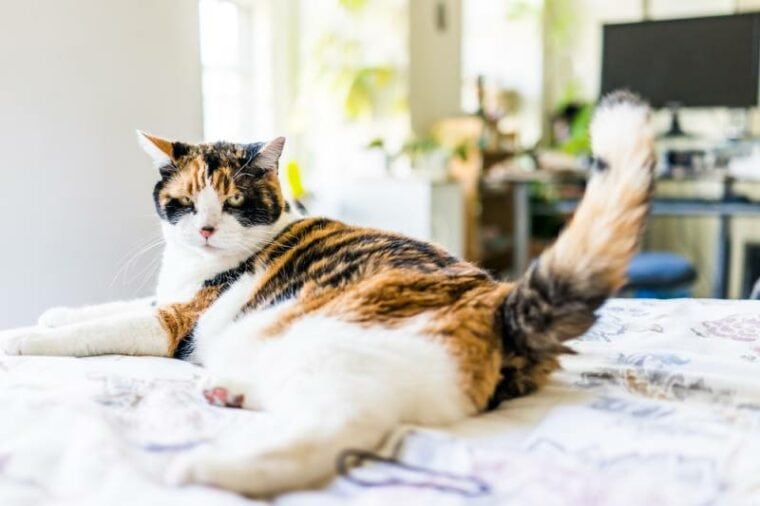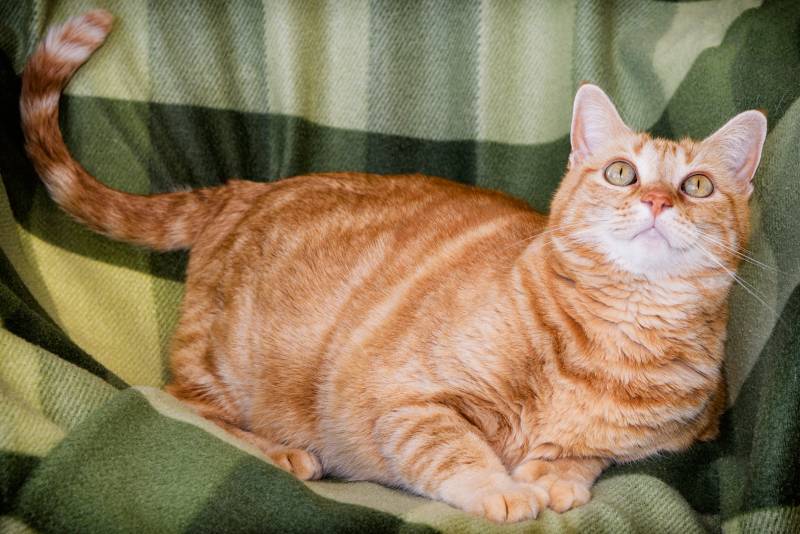
Cats are interesting creatures, and many of their behaviors remain a mystery. One such behavior is wagging their tails while lying down. If you’ve ever seen your cat do this, you may have wondered why.
While most people think that this is just a sign of relaxation, there are several reasons why cats do this.
This article will explore the eight reasons cats wag their tails while lying down. We’ll also discuss what this behavior might mean regarding their mood and overall health.
What Is Your Cat Trying to Say?
When cats wag their tails while lying down, they display their emotions in a different way that’s unique from when standing. They wag their tails this way as an expression of their emotions. But, depending on the situation, this expression can be interpreted differently.
That’s why paying attention to your cat is important since it can reveal much about its intentions. Here are eight reasons your cat may wag its tail while lying down.

The 8 Reasons Cats Wag Their Tails While Lying Down
1. The Desire to Bond
Once domesticated cats are neutered, they’re no longer fighting for mates. This lack of competition causes them to develop strong social bonds, often manifesting in mutual grooming or cuddling. Cats wagging their tails while lying down shows contentment, trust, and friendship.
In addition to forming bonds with their owners, cats may also show this behavior when encountering other cats. They may want to reassure the other cat that they’re not a threat and to express their desire to be accepted into the group.
2. Display of Happiness
Cats are quite expressive when it comes to showing their emotions. When cats wag their tails while lying down, it indicates how happy and content they are. This behavior can also be a sign that they’re feeling comfortable and safe. If you’ve ever seen your cat rolling around and wagging their tail, this also means that they’re feeling happy and content.
Cats are naturally curious and playful creatures, so their tail wagging expresses excitement and joy. They might also use their tail to express their happiness and satisfaction when lying down.

3. Communication
Cats are social animals who need interactions with others to stay healthy and content. When cats see other cats, they may wag their tails while lying down to communicate different messages. For instance, they may use it to indicate their friendliness or signal that they feel friendly and willing to engage with other cats.
Cats also show this behavior when they feel nervous or scared. A tail wagging can indicate that the cat feels uncertain about the situation and is looking for a way out. Tail wagging can also signify that the cat is trying to spread their scent to show others that this is its territory.
4. Scent Exchange
Cats have a powerful sense of smell, and they use it to keep track of their environment. When cats wag their tails while lying down, it’s a way for them to exchange their scents with others.
When cats wag their tails while lying down, it also releases pheromones. These scent molecules make up a cat’s identity and serve as a way to mark its territory. When cats exchange these molecules, they are communicating their identities and whereabouts.

5. Balance
Apart from expressing their emotions, cats wag their tails while lying down to keep their balance. They’re less stable in this position, and their body has to adjust more quickly to sudden movements. Their tail helps them keep their balance in this position by providing extra support when needed.
Cats use their tail to partially suspend their body in the air to help move their centers of gravity and provide more leverage. This helps them adjust and reposition themselves quickly, enabling them to stay upright and maintain their balance.
6. Playfulness
Some cats may wag their tails while lying down as a sign of excitement or anticipation of playtime. This could express their eagerness to play or activity with their owner or another cat.
When your cat feels playful or excited, it may wag its tail back and forth rapidly or twitch the tip of its tail and also meow in a gentle, playful voice. When this happens, grab toys such as balls, stuffed animals, and interactive toys. Cats love to chase and pounce, so toys that move or can be thrown are often a hit.
Always keep your cat’s toy selection fresh by rotating them frequently. This can help prevent boredom and keep your cat interested in playing. Also, encourage healthy play behaviors to avoid aggressiveness.

7. Irritation or Discomfort
Like humans, cats can show irritation and discomfort by wagging their tails while lying down. There are various reasons why your cat might be irritated or uncomfortable.
A vigorous and abrupt tail wagging from your cat often signifies irritation or discomfort. If you notice this type of tail wags from your cat lying down, it is best to leave them alone.
8. Alertness
Cats may also wag their tails while lying down to stay alert and aware of their surroundings. When your cat is lying down and wagging their tail slowly, it may indicate they feel wary of their surroundings.

Are There Different Types of Wags Your Cat Might Display?
From slow, gentle wags to wild, frenzied cramps, your cat may show various tail wags while lying down. Your cat’s physical and emotional state can greatly affect the type of wag. For instance, if your cat feels calm and content while lying down, they might give a few gentle swishes of the tail.
However, if they’re feeling anxious or threatened, their tail may become rigid, and they may twitch it back and forth. It’s important to pay attention to both the speed and intensity of the wag. The more intense the wag, the stronger the emotion your cat is trying to communicate to you.
Conclusion
Cats often wag their tails while lying down to communicate with you. It is best to pay attention to the context in which your cat is wagging its tail, as this can provide valuable clues about its emotional state and needs.
If you need clarification on what your cat is trying to communicate, it’s always a good idea to consult a veterinarian or animal behaviorist. Also, remember that all cats are different, and they may show different behavioral patterns.
By understanding your cat’s tail movements and other behaviors, you can develop a deeper bond with your pet and provide them with the care and attention they need to thrive.
Featured Image Credit: Kristi Blokhin, Shutterstock







